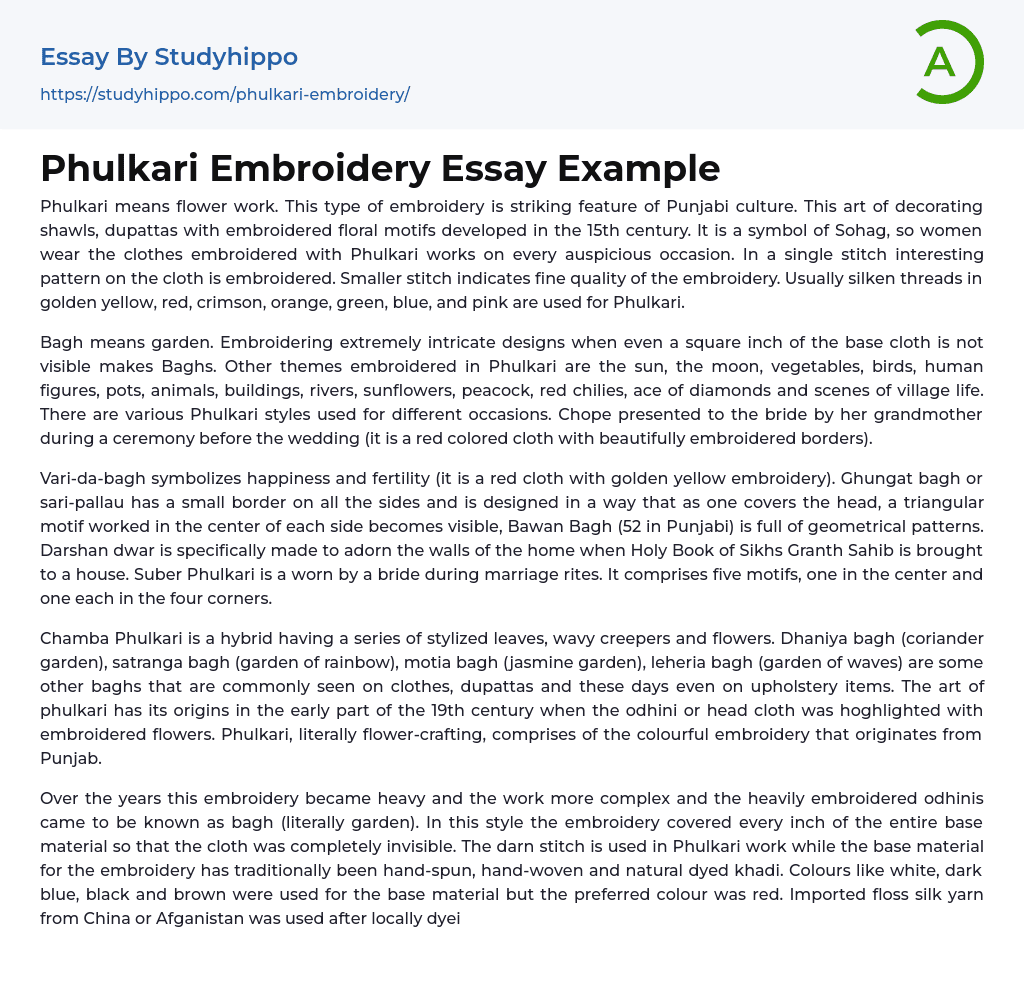Phulkari means flower work. This type of embroidery is striking feature of Punjabi culture. This art of decorating shawls, dupattas with embroidered floral motifs developed in the 15th century. It is a symbol of Sohag, so women wear the clothes embroidered with Phulkari works on every auspicious occasion. In a single stitch interesting pattern on the cloth is embroidered. Smaller stitch indicates fine quality of the embroidery. Usually silken threads in golden yellow, red, crimson, orange, green, blue, and pink are used for Phulkari.
Bagh means garden. Embroidering extremely intricate designs when even a square inch of the base cloth is not visible makes Baghs. Other themes embroidered in Phulkari are the sun, the moon, vegetables, birds, human figures, pots, animals, buildings, rivers, sunflowers, peacock, red chilie
...s, ace of diamonds and scenes of village life. There are various Phulkari styles used for different occasions. Chope presented to the bride by her grandmother during a ceremony before the wedding (it is a red colored cloth with beautifully embroidered borders).
Vari-da-bagh symbolizes happiness and fertility (it is a red cloth with golden yellow embroidery). Ghungat bagh or sari-pallau has a small border on all the sides and is designed in a way that as one covers the head, a triangular motif worked in the center of each side becomes visible, Bawan Bagh (52 in Punjabi) is full of geometrical patterns. Darshan dwar is specifically made to adorn the walls of the home when Holy Book of Sikhs Granth Sahib is brought to a house. Suber Phulkari is a worn by a bride during marriage rites. It comprises five motifs, one in the center and one eac
in the four corners.
Chamba Phulkari is a hybrid having a series of stylized leaves, wavy creepers and flowers. Dhaniya bagh (coriander garden), satranga bagh (garden of rainbow), motia bagh (jasmine garden), leheria bagh (garden of waves) are some other baghs that are commonly seen on clothes, dupattas and these days even on upholstery items. The art of phulkari has its origins in the early part of the 19th century when the odhini or head cloth was hoghlighted with embroidered flowers. Phulkari, literally flower-crafting, comprises of the colourful embroidery that originates from Punjab.
Over the years this embroidery became heavy and the work more complex and the heavily embroidered odhinis came to be known as bagh (literally garden). In this style the embroidery covered every inch of the entire base material so that the cloth was completely invisible. The darn stitch is used in Phulkari work while the base material for the embroidery has traditionally been hand-spun, hand-woven and natural dyed khadi. Colours like white, dark blue, black and brown were used for the base material but the preferred colour was red. Imported floss silk yarn from China or Afganistan was used after locally dyeing.
The embroidering is done from the reverse side of the fabric with the silk yarn which gives a shaded effect to the fabric. The uniqueness of this work is that the fabric itself is used as an inner decoration so that the pattern sewn on becomes an integrated combination of colours. The smoothness on the reverse of the fabric speaks volumes of the quality of workmanship and skill of the embroider. The motifs used are karela bagh, gobhi bagh, dhaniya
bagh and mirchi bagh are based on motifs inspired by vegetables while shalimar charbagh and chaurasia bagh are motifs based on the famed gardens.
- Accounting essays
- Marketing essays
- Automation essays
- Business Cycle essays
- Business Model essays
- Business Operations essays
- Business Software essays
- Corporate Social Responsibility essays
- Infrastructure essays
- Logistics essays
- Manufacturing essays
- Multinational Corporation essays
- Richard Branson essays
- Small Business essays
- Cooperative essays
- Family Business essays
- Human Resource Management essays
- Sales essays
- Market essays
- Online Shopping essays
- Selling essays
- Strategy essays
- Management essays
- Franchising essays
- Quality Assurance essays
- Business Intelligence essays
- Corporation essays
- Stock essays
- Shopping Mall essays
- Harvard Business School essays
- Harvard university essays
- Trade Union essays
- Cooperation essays
- News Media essays
- Waste essays
- Andrew Carnegie essays
- Inventory essays
- Customer Relationship Management essays
- Structure essays
- Starting a Business essays
- Accounts Receivable essays
- Auditor's Report essays
- Balance Sheet essays
- Costs essays
- Financial Audit essays
- International Financial Reporting Standards essays
- Tax essays
- Accountability essays
- Cash essays
- Principal essays




